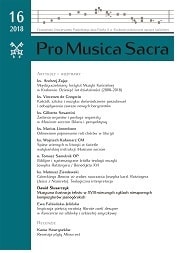Odnowione pojmowanie roli chórów w liturgii
The renewed understanding of the role of a choir in liturgy
Author(s): Marius LinnenbornSubject(s): Christian Theology and Religion, Theatre, Dance, Performing Arts, Music, Sociology of Art, Sociology of Religion
Published by: Wydawnictwo Naukowe Uniwersytetu Papieskiego Jana Pawła II w Krakowie
Keywords: liturgical movement; cecilian movement – cecilianism; music and singing in liturgy; schola; church choir; liturgical choir; men’s choir; boys’ choir; capella musica; Cappella Sistina; Pius X; Pius XI;
Summary/Abstract: The author indicates a few crucially significant issues arisen after the Second Vatican Council, namely the revival of music and singing in liturgy, particularly the role of a choir, and the questions of a repertoire, choir composition and voice arrangement during liturgy entailing the problem of women’s inclusion into the choir. Through his most exhaustive, against the paper limitations, historical analysis, the author demonstrates how the role of the choir in liturgy was understood at the beginning and how this understanding has evolved over the years. The author emphasizes as well a vital role of children choirs in liturgy, advocated by the liturgical movement which originally assumed children’s singing in a schola or a choir as a “pioneering function for singing of the faithful”. One of the main propagator of the above pioneering function of children’s singing was Pius Parsch, founder of the Volksliturgiche Bewegung. Pope Paul VI used beautiful words to describe the role of singing children when addressing Pueri Cantores: “We trust that you will become co-participants or even the pioneers of a concrete and practical liturgy revival of our liturgical assembly. Wherever children sing, the faithful pray and wherever children are silent, the faithful reluctantly open their mouths to sing”. Just like sacred music plays a servicing role in liturgy (cf. CL 112) “the primary and the most essential function of a choir or of a cantor is to serve the faithful in their singing during liturgy, not to replace them. The secondary function is to perform by the choir the singing parts which the faithful are not capable of performing on their own and on a high artistic level” (the Austrian liturgist Philipp Harnoncourt). In his letter celebrating the 100th anniversary of publishing motu proprio by Pius X on 22 November 1903, Pope John Paul II highlighted the double role of a choir: “The task of the schola has not decreased: it indeed develops in the assembly the role of guide and support and, at certain moments of the Liturgy, has its own specific role“. Pope Benedict XVI defied the exclusive singing of the faithful and of liturgical music, ascribing to the choir singing an equivalent value: „there are a good number of people who can sing better «with their heart» than «with their mouths», but their hearts are really stimulated to sing through the singing of those who have the gift of singing «with their mouths». It is as if they themsleves actually sing in the others; thankful listening is united with the voices oft he singers in the one worship of God”.
Journal: Pro Musica Sacra
- Issue Year: 16/2018
- Issue No: 16
- Page Range: 101-112
- Page Count: 12
- Language: Polish

